Disc capacitors offer stable performance and high voltage ratings, making them ideal for applications requiring durability and reliability. Multilayer capacitors, with their compact size and high capacitance, suit space-constrained designs and high-frequency circuits; discover which capacitor best fits your project by exploring the detailed comparisons ahead.
Comparison Table
| Feature | Disc Capacitor | Multilayer Capacitor (MLCC) |
|---|---|---|
| Structure | Single-layer ceramic disc | Multiple ceramic layers stacked |
| Capacitance Range | 1pF to 1uF | 1pF to 100uF |
| Voltage Rating | Up to 3kV | Up to 500V (commonly) |
| Size | Larger, bulkier | Compact, small size |
| Performance | Stable at high voltages | High capacitance in small footprint |
| Applications | High-voltage circuits, pulse circuits | General-purpose, filtering, decoupling |
| Cost | Generally lower | Generally higher due to manufacturing |
Introduction to Disc and Multilayer Capacitors
Disc capacitors consist of a ceramic disc as the dielectric material with metal electrodes on both sides, offering stable capacitance and high voltage tolerance ideal for high-frequency applications. Multilayer capacitors feature multiple ceramic layers stacked and connected in parallel, providing higher capacitance in a compact size, commonly used in surface-mount technology. Understanding your project's voltage, capacitance, and size requirements will help determine whether a disc or multilayer capacitor is best suited for your circuit design.
What is a Disc Capacitor?
A disc capacitor is a type of ceramic capacitor characterized by its round, disc-shaped dielectric made from ceramic materials, offering stable capacitance and low inductance. It typically features two metal electrodes deposited on opposite sides of the ceramic disc, providing reliable performance in high-frequency applications. Compared to multilayer capacitors, disc capacitors generally have lower volumetric efficiency but excel in high voltage and pulse handling capabilities.
What is a Multilayer Capacitor?
A multilayer capacitor is a type of ceramic capacitor composed of alternating layers of metal electrodes and dielectric material stacked together to achieve high capacitance in a compact size. Unlike disc capacitors, which have a single-layer dielectric, multilayer capacitors provide improved stability, reliability, and lower equivalent series resistance (ESR), making them ideal for high-frequency and precision applications. Their multilayer construction enables smaller form factors with enhanced capacitance values, commonly used in surface-mount technology (SMT) devices.
Construction Differences
Disc capacitors consist of a ceramic dielectric material shaped into a disc sandwiched between two metal electrodes, providing a simple and compact structure. Multilayer capacitors (MLCCs) have multiple alternating layers of ceramic dielectric and metal electrodes stacked internally, allowing higher capacitance in a smaller volume. The layered construction of MLCCs improves capacitance density and stability compared to the single-layer design of disc capacitors.
Material Composition
Disc capacitors typically use ceramic dielectric materials composed of metal oxides like titanium dioxide or barium titanate, providing stable performance in high-frequency applications. Multilayer capacitors (MLCCs) consist of multiple thin ceramic layers stacked with alternating metal electrodes, enhancing capacitance in a compact form factor. Your choice between these capacitors depends on the required capacitance, tolerance, and physical size constraints influenced by their distinct material compositions.
Electrical Performance Comparison
Disc capacitors typically exhibit higher voltage ratings and superior pulse handling capabilities compared to multilayer capacitors, making them ideal for high-voltage applications. Multilayer capacitors offer lower equivalent series resistance (ESR) and capacitance values with high precision, which benefits high-frequency and signal filtering circuits. You should choose based on the specific electrical requirements, balancing voltage endurance against capacitance stability and frequency performance.
Size and Capacitance Range
Disc capacitors typically offer smaller capacitance values, generally ranging from a few picofarads up to several microfarads, and feature a compact, disk-shaped design ideal for high-frequency applications. Multilayer capacitors (MLCCs) provide a broader capacitance range, from picofarads to several hundred microfarads, while maintaining a significantly smaller size due to their stacked internal structure. Your choice between these capacitors depends on the required capacitance and the physical space limitations within your circuit design.
Common Applications
Disc capacitors are commonly used in high-frequency circuits, EMI suppression, and pulse handling due to their low inductance and high stability. Multilayer capacitors (MLCCs) dominate in digital electronics, decoupling, and surface-mount technology applications because of their compact size and high capacitance per volume. Both types are essential in power supplies, automotive electronics, and consumer devices for filtering, timing, and energy storage tasks.
Advantages and Disadvantages
Disc capacitors offer high voltage ratings and excellent tolerance for surge currents, making them suitable for high-frequency and high-voltage applications, but they tend to be larger and less stable under varying environmental conditions. Multilayer capacitors provide a compact size, higher capacitance per volume, and superior stability, which is ideal for miniaturized electronic devices, yet they generally have lower voltage ratings and can be more prone to mechanical stress damage. Selecting between disc and multilayer capacitors depends on the specific requirements for size, voltage, capacitance, and environmental durability in circuit design.
How to Choose: Disc or Multilayer Capacitor?
When choosing between disc and multilayer capacitors, consider the application requirements such as capacitance range, voltage rating, and frequency response. Disc capacitors typically offer higher voltage ratings and are suitable for high-voltage, pulse, and AC applications, while multilayer ceramic capacitors (MLCCs) provide higher capacitance in compact sizes, making them ideal for high-frequency, low-voltage circuits. Evaluate factors like size constraints, reliability, and performance stability under temperature variations to select the optimal capacitor type.
disc capacitor vs multilayer capacitor Infographic

 solderic.com
solderic.com